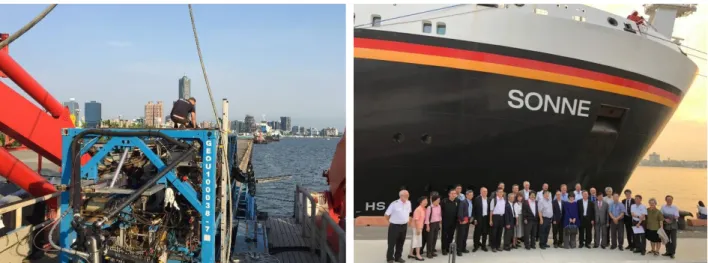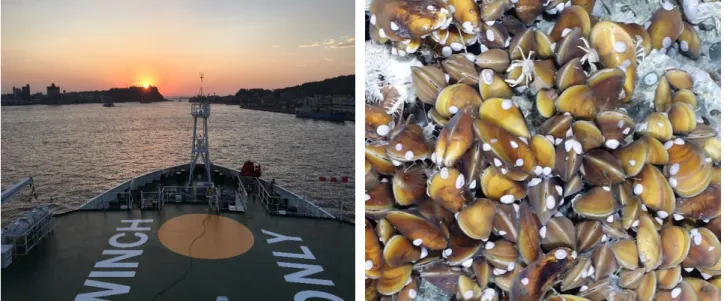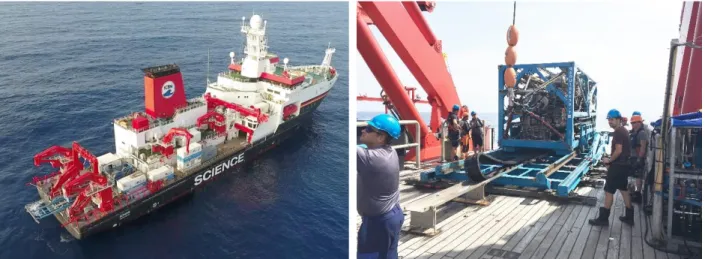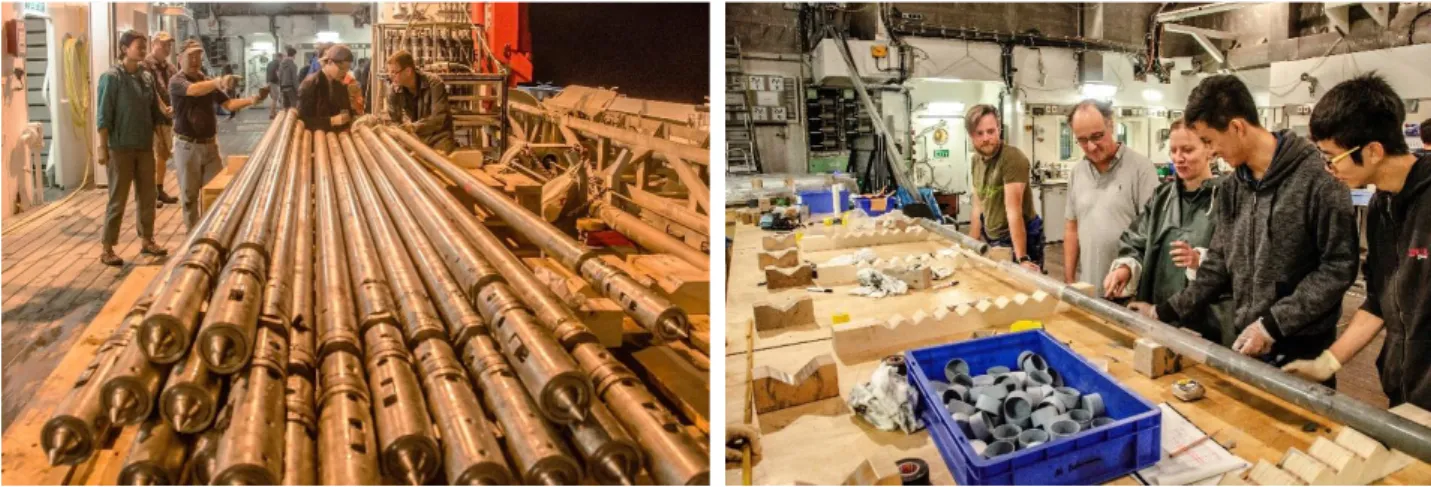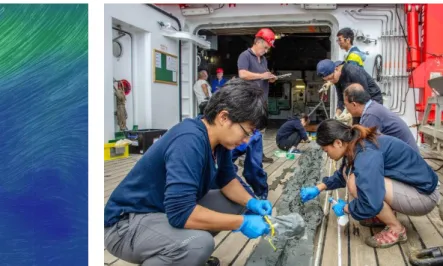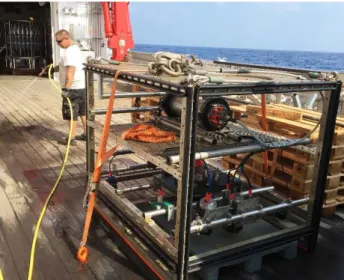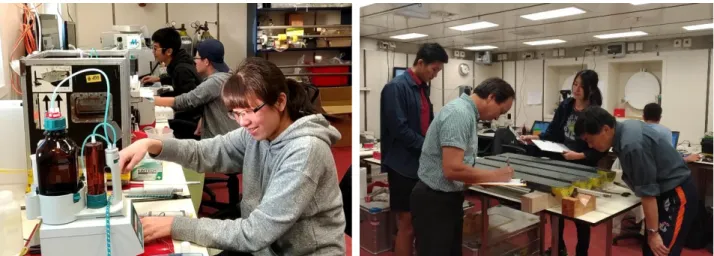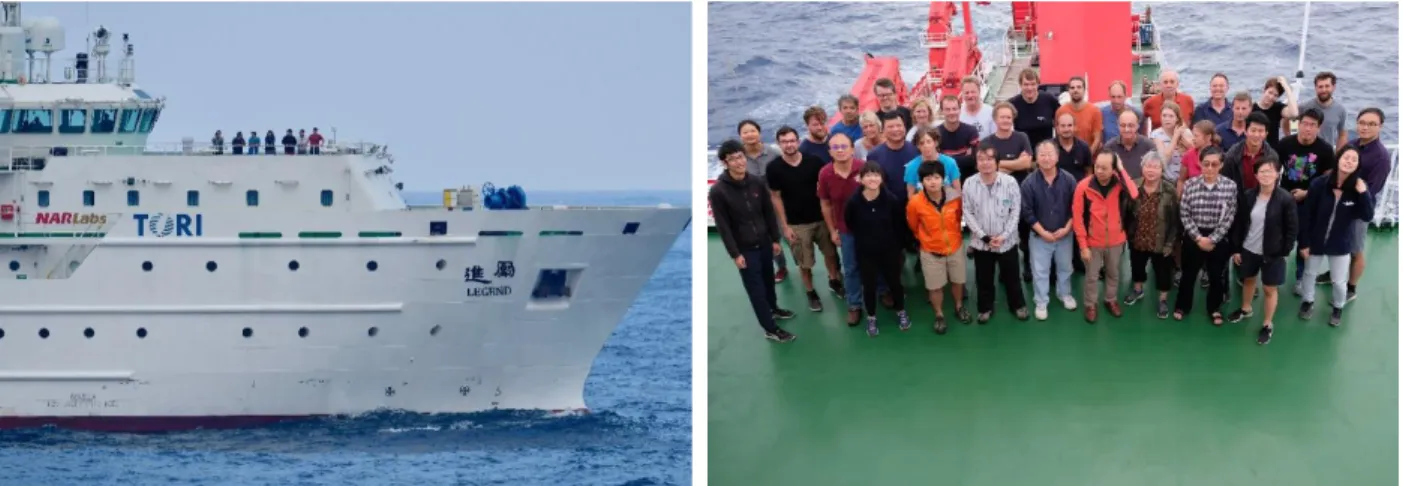Research Vessel SONNE
SO266:
Kaohsiung – Kaohsiung
1st Weekly Report: 10 – 21 October 2018
On Monday 15 October 2018 at 05:12 p.m. local time, RV SONNE left her berth at Pier 7 in Kaohsiung seaport to investigate the distribution of methane hydrates at the Taiwanese continental margin by using the mobile seafloor drill rig MeBo200 (Abb. 1). Before we had five days of intense work on board, mobilizing the equipment for the expedition. We arrived at the ship on Wednesday 10 October. First two containers from the cruise before had to be unloaded. When the eleven containers for our cruise SO266 arrived we had to install nine containers onboard and one 20‘ and one 40‘ container had to be discharged. The extended stay in the port was necessary for the setting up MeBo. During the mobilization, the 12 people-strong installation crew from Germany had the opportunity to take in the bustle of urban life of Kaohsiung a 2.7 million city and its seaport which is the biggest of Taiwan and the 13th biggest in the world. Most of the Taiwanese oil import is passing through this port onto the industry around.
Fig. 1: Setting of seafloor drill rig MeBo200 in the trade port with a view on Kaohsiung‘s downtown silhouette (© Gerhard Bohrmann).
Fig. 2: Participants of the reception on Friday 12 October at Kaohsiung Banana-Pier on the occasion of research vessel SONNE’s visit (© Saulwood Lin).
On Friday 12 October SONNE moved to the so-called Banana Pier whose name refers to the former main export good bananas that was handled on this pier. Nowadays this berth with its former warehouses has been developed into a very attractive maritime leisure and culture area, that is enjoyed by Taiwanese families and tourists alike. By assistance of the Honorary Director of the German Institute in Kaohsiung and using the mayor’s press distributor list, journalists had been invited to attend a press event onboard RV SONNE.
Numerous journalists used the opportunity to see the ship and its research facilities, and to get information on the Taiwanese-German Research project on marine methane hydrates. More than 30 visitors were invited to the following reception in the vessel’s hangar (Fig. 2). Along with representatives of the seaport, the German Institute in Taipei, also the Director General of the Taiwanese Ministry of Science and Technology, Mrs. Hsinya Huang had arrived. Consequently, the port visit of the German research vessel and the joint Taiwanese-German research program on methane hydrates in the ocean lead to a considerable echo in local and nationwide press.
At the weekend further scientists from Germany and Taiwan arrived and set up their own labs on the ship.
After having discharged another container with ship equipment from Germany, we finally heard the command „cast off‘ on Monday 15 October, and SONNE left the natural port of Kaohsiung in a beautiful
sunset (Fig. 3). The elongated port basin is separated by the narrow but 8.5 km-long Qijin Island that consists of a former raised coral reef (Fig. 3), and an offshore sandbank in the South towards Taiwan Strait.
Fig. 3: RV SONNE leaving the port of Kaohsiung under the early evening sun and heading the northern port exit (© Gerhard Bohrmann).
Fig. 4: Compact field of chemosynthetic mussels with small white limpets and different crabs 1320 m water depth on Four-Way- Closure Ridge (© RV SONNE, SO266).
After a 24-sea-mile transit, we crossed the EEZ border of Taiwan and carried out a CTD cast for measuring the water sound velocity. These data were used to calibrate the ship’s own multi-beam system. The subsequently acquired seafloor maps of the so-called „Four-Way-Closure–Ridge“, once more documented the superior quality of SONNE’s multi-beam system which is the biggest that was ever installed on any research vessel.
Tuesday 16 October was used to install the newly acquired OFOS (ocean floor observation system) on board and to take two gravity cores while the MeBo-team finished the last preparations for the first drilling. After collecting more multi-beam data during the night, on Wednesday 17 October, the MARUM MeBo200 was deployed to the seafloor. The drill site was chosen based on a comprehensive geophysical experiment that was carried out during SO227 in 2013. In particular the seismic 3D seismic data proved to be an invaluable tool for deciding on the final drilling location because it allows to image the subsurface with a resolution of 3.5 m. By means of a micro-bathymetry map which had been acquired by an autonomous underwater vehicle (AUV) by our Taiwanese colleagues, we could find an acceptable slope gradient for MeBo. After MeBo had landed on the seafloor successfully it drilled to 21 m below seafloor. Unfortunately, there was a small leak in the hydraulic system and we had to retrieve the drill rig. When redeploying after the repairs on the next day the winch malfunctioned and only on Sunday 21 October we could start drilling again. In the meantime, the sediments we had recovered with MeBo and the gravity corer had been processed.
Two heat-flow transects, one CTD transect and three OFOS dives and further hydro-acoustic mapping completed the program. Especially impressing were the OFOS-derived seafloor imagery. It was easy to maneuver the instrument on the seafloor based on the AUV micro-bathymetry and the backscatter intensity maps and we could identify several active fluid- and gas emissions based on the benthic ecosystems (Fig. 4) on the „Four-Way-Closure-Ridge“ in 1340 m water depth. Due to a military exercise in that area we had to leave and are now drilling successfully on Formosa Ridge. Details on that will be given in our next weekly report.
Weather conditions so far are very good and did not lead to any restriction of our station work.
Best regards on behalf of the cruise participants,
Gerhard Bohrmann RV SONNE, Sunday 21 October 2018
Research Vessel SONNE
SO266:
Kaohsiung – Kaohsiung
Second weekly report: 22. – 27.10.2018
The second week at sea turned out to be very exciting as we started on Sunday evening with a MeBo drilling on the Formosa Ridge in our western working area on the Chinese continental margin, which is part of the Eurasian Plate. To the east of it lies the Taiwanese continental margin, which has a completely different geological structure as it is a convergence zone of the lithospheric plates. In this area southwest of Taiwan, we have the opportunity to conduct comparative investigations of the methane hydrate distribution at these different continental margins. We would like to understand by way of example the different tectonic influences on the gas hydrate distribution and dynamics. Geophysical surveys have been carried out in this area for many years, but up until now drilling for methane hydrates in the sediments has been lacking. Although drilling data are very important to calibrate the geophysical measurements.
The MeBo200 drill hole (Fig. 1 & 2) on Formosa Ridge was the first one we have drilled. Formosa Ridge is an elongated, submarine ridge about 40 km long and 7 km wide. It runs perpendicular to the continental slope and is bounded on both sides by deep canyons. With slope angles of more than 10 and up to over 30 degrees, it was difficult to find a stable landing site for MeBo that was interesting in terms of the geological structures that we had selected from the GEOMAR 3D seismic data. For MeBo we need a seabed dip of less than 5 degrees slope. In order to find such a place in 1,300 m water depth, we used an AUV-based micro-bathymetric survey from which we have converted the depth to a fairly accurate slope map. This allowed us to identify a flat plateau of 100 m in diameter on the narrow crest of Formosa Ridge. This turned out to be very suitable and after a safe landing on the seabed, MeBo could start drilling.
Figure 1: Research vessel SONNE with its large working deck is the ideal platform to deploy the MeBo200, which arrived from Bremen with seven blue / white containers now placed on the SONNE (© Christian Berndt).
Figure 2: After all the functions of the MeBo200 and its winch have been tested, the drilling rig on its launching system is driven aft over the edge of the ship before being rotated 90 ° to the seabed (© Gerhard Bohrmann).
With 33 core barrels, the sediment sequence was drilled down to a sediment depth of 109.91 m below the seafloor. The recovered sediments consist mainly of very fine-grained hemipelagic muds with low methane hydrate saturations in about 20-30 m sediment depths and higher methane hydrate concentrations at 98 m depth and below. The methane hydrates, which were very likely disseminated in the sediment, had decomposed on the way through the water column and onto the deck of the research vessel. But some data, such as the chloride content in the pore water, proved that we had penetrated methane hydrates. Based on
the chloride anomalies, we can also quantify the saturations of methane hydrate very well. At a sediment depth of 86 m, we penetrated a very prominent seismic reflector, which is caused by a carbonate cementation zone. In addition to abundant limestone shells numerous diagenetically-formed calcareous nodules were found. We suspect that this cementation zone constitutes a seal for ascending methane, which solidified below with the pore water to methane hydrate. Two borehole logging probes produced particularly valuable extra data during the removal of the drill string. Both the measured acoustic velocities and the values of the natural gamma radiation in the borehole are perfectly correlating with the drilled lithologies, so that a correlation of the drilling data to the 3D seismic data is possible.
Figure 3: After using MeBo200, the core barrels are removed from the magazines on deck and piled up for the scientists. First, a sediment sample is taken to determine the gases before the sediment-filled liners are pulled out of the core barrels (© Paul Wintersteller).
Figure 4: Due to the pressure relief of the sediment cores in the MeBo during ascent in the water column and in the laboratory as well as by gas hydrate decomposition, gas bubbles expand to create voids in the sediment cores. Voids have been taken into account by the scientists when working on the cores (© Paul Wintersteller).
The seabed drill was able to complete a second deep hole on "Four Way Closure Ridge" after just 14 hours on Thursday, 25 October. In contrast to the Formosa Ridge, the Four-Way-Closure-Ridge is an accretionary ridge, which was lifted up on the upper plate due to subduction. The compressional stress at this active margin generates different pathways for vertical methane ascent, which should also be expressed in the methane hydrate distribution. During mapping we found significantly more sea floor gas emissions in the form of acoustic water column anomalies than on and around Formosa Ridge. Drilling on Four-Way-Closure-Ridge sampled a sediment sequence of 126.35 m. After recovery of MeBo on board the ship the scientists had to deal with 32 core barrels of 3.50 m in length (Fig. 3). A detailed work plan for the scientists ensured a systematic and fast processing of the core liners. After gas sampling of the core catcher, the liners filled with sediment were scanned for temperature anomalies with an IR-camera and were then divided into individual sections and labeled. Since this Sunday morning, the sections were split into 2 halves lengthwise, described for details in sedimentology, photographed and sampled.
In the coming days, we will have to adapt our station work to the movements of the approaching typhoon YUTU from the east. With a western trail, the typhoon will cross the island Luzon of the Philippines and reach the South China Sea on Monday, where it is forecast to abate. A stable high pressure system above central China leads to a northeasterly winds causing a lee off Taiwan, where a significantly lower wave heights than in the rest of the South China Sea may be expected.
All participants are healthy and are happy to enjoy the good meals of our cooks. Greetings in the name of all cruise participants,
Gerhard Bohrmann FS SONNE, Sunday, October 28, 2018
Research Vessel SONNE
SO266:
Kaohsiung – Kaohsiung
Third weekly report: 28 October – 4 November 2018
The more than 100 m deep borehole on Four Way Closure Ridge resulted in more than 90.6% core recovery and kept us busy in the laboratories last weekend. Based on pore water chloride data, the geochemists were able to show that from 70 m below the seafloor, negative anomalies occur at several depth intervals, which can be explained by small but significant methane hydrate accumulations at those depth. The temperature of each core was measured with an infrared camera immediately after the core had been retrieved from its core barrel. This fast measurement of the still unopened liner indicates discrete gas hydrate accumulations by a temperature that differs significantly from the overall core (Fig. 1). As gas hydrates are not stable at the pressure/temperature conditions aboard the ship, they decompose into their components, i.e. water and methane. This fairly rapid decomposition is an endothermic reaction that consumes heat from the immediate environment. As a result, we saw pronounced cold sections of the core. Since we scanned all cores from the seabed drilling rig with this fast method, methane hydrate accumulations above a certain gas hydrate concentration were detected very well and the intervals coincided with those for which the geochemists found the chloride anomalies. Then, all sediment cores were logged with the multi-sensor core logger before they were split into archive and work halves (Fig. 2). Our Taiwanese colleagues from TORI (Taiwan Ocean Research Institute), a national institute in Taiwan similar to our Helmholtz institutions in Germany, provided the logger in a laboratory container for this cruise. On a calibrated bench (Fig. 2) physical properties of the cores, such as density, magnetic susceptibility, conductivity and P-wave velocity are measured. These data are in turn compared with the other data from the core description, the geochemical data and the high- resolution 3D seismic data.
Figure 1: Infrared measurements of two Mebo sediment cores using an IR-camera. Cold intervals with temperature anomalies of 2 - 8 ° C indicate the locations of the gas hydrate deposits in the cores just after the cores have been retrieved. (© Bryan Niederbockstruck).
Figure 2: Before the sediment cores are separated lengthwise and sampled, they are examined for their physical properties using the multi-sensor core logger in the container from TORI Institute of Taiwan (© Paul Wintersteller).
Very helpful for the localization of previously existing gas hydrates are also the measurements of the ratios of light hydrocarbons of gas samples, which are obtained with a special syringe from gas bubbles in the sediment liners. In sediment sections with methane hydrate, the ethane/propane ratio is significantly higher, since ethane is incorporated into the gas hydrate structure and is released again during hydrate
decomposition. In contrast, propane is not incorporated in the gas hydrate structure and accumulates in gas hydrate-free sediment sections.
As of Monday, October 29, we were impacted by the approaching super-typhoon YUTU, which had wind speeds of up to 195km/h and caused a strong to stormy north-easterlies in our working area. In our northwestern working area on Formosa Ridge station work was no longer possible. In the lee of Taiwan in our eastern working area, we were still able to perform station work with OFOS, CTD and gravity corer.
Unfortunately, on Tuesday we were expelled also from this area by a short-term military drill, so we had to move closer towards the Taiwanese coast to remain in a relative quiet area, 13 nautical miles off the coast.
On Thursday, November 1, the typhoon reached the South China Sea on its westward course, sweeping across the Philippines with wind speeds still up to 140 km/h and sadly doing a great deal of damage. We stayed in the lee of Taiwan at the safe distance (Fig. 3), but registered significantly increased wind speeds and wave movements. On Friday, October 2, after the cyclone abated, we conducted further station work on Four-Way- Clousure Ridge with OFOS, CTD, and gravity corer (Fig. 4). However, it was too early for a new MeBo mission, as there was still a strong swell from various directions, as a remainder of the typhoon, that prevented the deployment of the drilling system.
Figure 3: On Thursday, November 1, the already weakened Typhoon YUTU came closest to us. We therefore chose with RV SONNE the quietest corner in the southern lee of the island of Taiwan
(©https://earth.nullschool.net/#current/wind).
Figure 4: Scientists of the SONNE expedition sampling a core in a bag on the working deck. The use of a tubular bag instead of a plastic liner allows a much faster access to the sediments after the core has been hoisted on board (© Paul Wintersteller).
On Saturday, November 3, all signs of the typhoon had disappeared and we were able to launch the MeBo in bright sunshine. The positioning of the drilling system on the seabed was very difficult due to the geological conditions. The seafloor was very hummocky due to numerous limestone blocks. The ship’s photo and video sled (OFOS) had revealed only a few flat areas of about 10 m in diameter, in which a landing was possible. A new sonar called Echoscope helped us to find such a place. The Echoscope, which can see through a hatch in the bottom plate of the MeBo, is a sonar that provides in real time a very good 3D representation of the seabed. Using this technology from 40 m above the seafloor allowed us to find a suitable location on which the MeBo could land safely. The subsequent rotary drilling had to be stopped after 5.06 m due to gas bubbling from the well. A very well-preserved sequence of typical seep limestones with more than 85% core recovery, could be obtained.
A hump day party in the hangar of the ship on Wednesday, October 31, rounded off the first half of the journey, and we are looking forward to the scientific results of the second half.
Everyone is healthy; it greets in the name of all cruise participants
Gerhard Bohrmann FS SONNE, Sunday, 04 November 2018
Research Vessel SONNE
SO266:
Kaohsiung – Kaohsiung
Fourth weekly report: 05 – 11 November 2018
During the weekend MeBo took rotary cores from the carbonate formation on Four-Way-Closure Ridge (Fig.
1). Unlike other sediment cores, we did not split them lengthwise, but they remained in their liners to enable a CT analysis of the entire rock sequence when we get home. As the liners are transparent, it was possible to do a first macroscopic analysis. Different bright aragonite-rich horizons could be identified between darker, micrit-rich layers. The age of the sequence will be analyzed with U / Th dating in order to correlate the temporal evolution of methane emissions with the geological development of the Four-Way Closure Ridge.
Figure 1: Detail of the carbonate cores drilled in the seep area of the Four-Way-Closure-Ridge with MeBo. The dating of these rocks will provide information on the evolution of the seep activity (© Andrew Lin).
Figure 2: Formosa Seep is located on the summit of the Formosa Ridge and is characterized by active emission of methane gas, which appears acoustically through distinct flares (© Paul Wintersteller).
On Sunday, 4 November, we left our eastern working area and moved back to the passive continental margin of the South China Sea in the area of Formosa Ridge. A gravity corer at the MeBo station yielded astonishing results. In the 8,11 m-long sediment core of fine-grained, very homogenous mud, two to three fluid channels could be traced over large parts of the gravity corer length. These channels appear to be caused by gas bubble ascent in the sediment. Since the channels were significantly more water-rich, we believe that the channel walls were covered with gas hydrates, which have decomposed during the recovery of the core. As these observations were also made in the previously acquired MeBo core on Formosa Ridge, this suggests wide-spread gas bubble ascent in the sediments.
The next MeBo drilling began on Monday, 5 November, on the small plateau southeast of the Formosa Seeps. A first drilling at this location two weeks ago cored a sediment sequence of 108 m, where gas hydrates could be detected in two layers. In the upper layer between 15-42 m sediment depth, gas hydrates showed a saturation of the pore space of 10%, while the layer below 100 m reached a gas hydrate saturation of approximately 33%. The second hole at this location was not drilled to recover sediment cores, but it was only drilled to perform logging. In addition to natural gamma radiation, electrical resistivity was logged, which clearly imaged the two horizons of hydrate in the borehole. This measurement was able to show the presence of gas hydrate down to a depth of 120 m, which had not been sampled previously.
The maximum of natural gamma radiation was between about 80 and 90 m and represents a layer with numerous carbonate nodules, which seem to change the fluid circulation pathways. Two horizons with volcanic ash at 39 and 72 m depth represent the explosive volcanic eruptions on the Philippine island of Luzon that happened 39,000 and 61,000 years ago according to dated sediment cores. Together with the
micro-paleontological examinations of our Taiwanese colleague Prof. Kuo-Yen Wei, these age determinations already give us on board a rather good age model for the sediment sequence.
During MeBo drilling on the small plateau, we have repeatedly observed gas emissions (Fig. 2) with the ship's hydro-acoustic systems on the summit area only 50-100 m to the north. The summit of this ridge segment is at 1120 m water depth and rises dome-like 15 m over the crest of the ridge. As recent publications by our Asian colleagues describe, the summit hosts one of the most interesting seeps of the South China Sea. On Wednesday, 7 November, we conducted observation profiles with the new OFOS (Fig.
3) over this seep area which is about 140 m wide. OFOS is a newly built video and photo imaging tool that was requested by the scientific community. It is operated by the ship’s science officers. It showed its outstanding qualities as a new working tool. The HD camera, the high-speed camera with a resolution of 30 megapixels, very good seabed illumination, and a modern deck unit that is linked by a fiber optic cable make OFOS a very valuable scientific instrument. The video footage of the seafloor was transmitted to all possible monitors on the ship. The flash unit on the OFOS allowed us to generate a digital image every 3 seconds so that entire photo transects can be assembled via photo mosaicking. This helps tremendously when interpreting the high-resolution maps that are based on the ship’s hydro-acoustic data.
Figure 3: The new "Ocean Floor Observation System" (OFOS), has a long tradition on R/V SONNE. It can be used for direct observation of the seabed since cruise SO265, (© Gerhard Bohrmann).
Figure 4: Central area of the Formosa Seep. The mussel field is almost completely covered by deep-sea crabs of the species Shinkaia crosnieri. The crabs are known from hydrothermal vents of the Okinawa Trough, but also live at cold seeps (© R / V SONNE, SO266).
In addition to blocky, rugged carbonate formations seep organisms are especially of interest. Mussels are ubiquitous. Apart from living mussels there is shell detritus, that is also found in the carbonate crusts. As chemosynthetic animals they depend on the dissolved methane and represent the main inhabitants of the seeps. A curiosity are the almost monospecific deep-sea lobsters, which in some places cover the entire seabed. Shinkaia crosnieri (Fig. 4) is mainly known from the hydrothermal vents of the Okinawa Trough, but they also live at cold seeps.
Meanwhile, we have finished eight drill holes with MeBo and hope to drill another two wells in the last week before sailing back to Kaohsiung next Sunday. We will report on this in the last weekly report. The weather seems to play along.
Everyone is healthy; it greets in the name of all cruise participants
Gerhard Bohrmann R/V SONNE, Sunday, 11 November 2018
Research Vessel SONNE
SO266:
Kaohsiung – Kaohsiung
Fifths and last weekly report: 12 – 18 November 2018
Last week, with the 10th and 11th MeBo drilling of this cruise, two important holes were drilled in the eastern working area in the accretionary wedge. On Monday and Tuesday, 12 and 13 November, we drilled 77.4 m deep on South Yungan East Ridge, recovering older sediments of the accretionary ridge below a geological unconformity. Unfortunately, the hope of drilling gas hydrates in the fracture zones that are visible in the seismic data was not fulfilled. While indications of large gas volumes were ubiquitous, there were no indicators of gas hydrates, such as chemical anomalies, or soupy layers in the sedimentary sequence. The well-trained work force in all laboratories (Figures 1 and 2) ensured that we were able to present all data from this drilling as early as Wednesday, November 14, as part of the daily science meeting at 15:30. The MeBo team started on this day with our last hole on Four Way Closure Ridge, which was aimed at drilling a deep sediment sequence between 115 and 140 meters, which is represented by high amplitudes in seismic data. An earlier hole that we drilled at the same site previously only reached depths of 126 meters, but showed signs of sand deposits, which have a high potential for gas hydrate presence. A second earlier hole at the location that used a different drilling technique, i.e. it did not core sediments but merely logged physical data of the rock formations at depths of up to 144 m. Based on the results we proposed numerous layers of sand at depth. In the new core drilling, which unfortunately did not quite reach the depth of 144 m, numerous sand layers were actually present, whose gas hydrate saturation could be determined with a high degree of confidence on the basis of the chloride and IR temperature anomalies. Thus, a very important goal to prove gas hydrate occurrences in coarse-grained accretionary wedge sediments was reached in the last week of the expedition.
Figure 1: View of the dry laboratory 1 of FS SONNE, where the chloride, sulfate, ammonium and hydrogen sulfide contents of the pore water are analyzed after each drilling (© Tzu-Ting Chen).
Figure 2: The geological processing of the sediment cores in wet laboratory 2. In addition to a detailed description of the cores, the first micro-paleontological investigations are also carried out (© Tzu-Ting Chen).
On Thursday and Friday, 15 and 16 November, we sampled the water column above the Formosa Seep with the ship's CTD at many sampling points around the seep area which has a diameter of approx. 140 m.
Significantly higher methane concentrations up to 2000 nM were measured in the sampled water, whose distribution pattern also clearly indicated the source at Formosa Seep. On Thursday morning, 15 November, we were visited by the new Taiwanese research vessel LEGEND, which TORI is currently commissioning (Fig.
3).
After nearly 5 weeks of intensive research on FS SONNE, we look back on eleven MeBo boreholes that we have successfully completed at 6 different locations. No other exploration could previously drill 8,300 feet with the MARUM seabed drill, with over 420 meters of drilling and over 350 sediment cores collected. This corresponds to a core recovery of more than 83% in predominantly difficult-to-recover gas-rich deposits, which expand during retrieval from their rock formation, so that it often comes to loss of sediments. Two pressure cores successfully recovered sediments with gas hydrates. Never before has MeBo completed over 480 meters of borehole logging. In addition, 15 CTD stations were carried out during the cruise, 9 gravity cores were taken and 26 heat flow measurements in surface sediments and 6 observation profiles on the seabed were carried out with the new OFOS. Between station work, the swath bathymetry and sediment echosounders measured over a distance of 4,180 km along the seabed, so that a bathymetric map of about 8,000 km2 with the highest resolution ever in Taiwanese waters could be created.
The success of the scientific work is also due to the excellent and friendly support of the ship's crew in all areas (nautic crew, WTD, deck crew, machine and service area, etc.) and the shipping company. For that, we thank master Lutz Mallon and his entire team, who supported us in all matters. Many thanks also go to the MeBo drilling team, which continuously advanced the drilling process during their shifts. R/V SONNE is ideally suited for research cruises with MeBo200 due to its ample deck space, cranes, laboratories and accomodation capacity (40 science berths). One of the highlights is the large space on the working deck, the large hangar and the cold rooms at working deck level, which greatly facilitate the handling long sediment cores. The joint cruise of GEOMAR in Kiel and MARUM Bremen is a scientific cooperation with Taiwanese institutes, whereby the National Taiwan University (NTU) in Taipei with Prof. Saulwood Lin is the coordinator on the Taiwanese side. The scientific post-processing of the valuable data collected during the SO266 expedition will be jointly performed during the upcoming months and presented at a first meeting in Taipei in October 2019 during the 9th TaiGer meeting.
Figure 3: On Thursday morning the Taiwanese research vessel LEGEND visited us. The ship was built in Vietnam, was recently acquired by the Taiwan Ocean Research Institute TORI and is still in the testing phase (© Berthold Schütte).
Figure 4: Group picture on the bridge deck. It's done; On Friday, November 16 at 08:00 the last station work of SO266 was completed with a CTD. The last two expedition days were used for seafloor mapping (© Berthold Schütte).
Today, 18 November, we reached the port of Kaohsiung and immediately began to clear the expedition equipment and the containers. While our Taiwanese scientists are already at home, most of us will return home by plane tomorrow.
Everyone is healthy; It greets one last time from this trip on behalf of all cruise participants (Fig. 4)
Gerhard Bohrmann R/V SONNE, Sunday 18 November 2018
